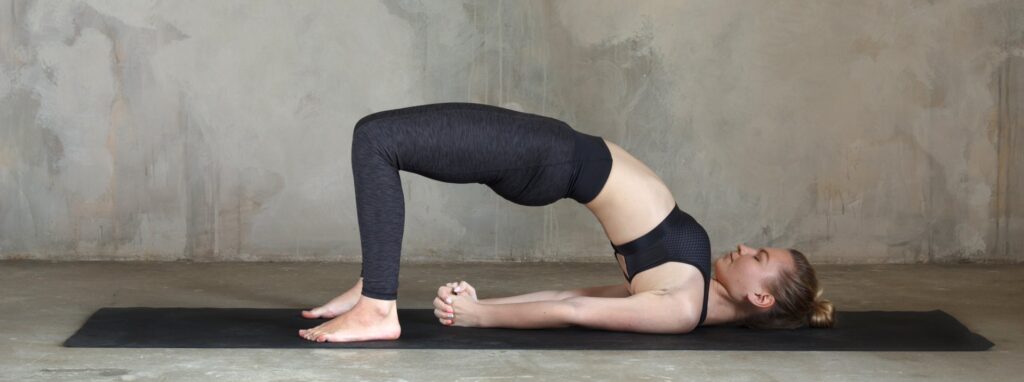“In Setu Bandhasana, we build a bridge between body and mind, strength and flexibility, and the present and the future.”
Bridge Pose, also known as Setu Bandha Sarvangasana in Sanskrit, is a fundamental yoga posture that offers a wide range of physical and mental benefits. In this pose, the body forms a bridge-like shape, with the weight resting on the shoulders and feet firmly grounded. Bridge Pose is renowned for its ability to strengthen the back, open the chest, and stretch the neck and spine. Additionally, it helps improve flexibility in the hip flexors and provides relief from stress and anxiety. Discover how to perform Bridge Pose correctly and explore its transformative effects on your well-being in this comprehensive guide.
Meaning of Setu Bandhasana
Setu Bandhasana draws its roots from ancient yogic traditions. The name “Setu Bandhasana” is derived from the Sanskrit words “setu,” which means “bridge,” “bandha,” which means “lock,” and “asana,” which means “pose.” This pose mirrors the form of a bridge, symbolizing the connection between mind and body—a bridge to unity and balance.
Strengths and Benefits of Bridge Pose
Despite its apparent simplicity, Bridge Pose is a treasure trove of advantages for your physical and mental well-being:
- Spinal Flexibility: It gently stretches and strengthens the spine, promoting flexibility and relieving tension.
- Hip and Chest Opener: Setu Bandhasana opens the hip flexors and chest, enhancing flexibility and improving posture.
- Strengthens Lower Body: The pose engages and strengthens the muscles of the lower back, buttocks, and legs.
- Stress Reduction: It calms the mind and reduces stress, as the gentle backbend promotes relaxation.
- Better Digestion: Regular practice can stimulate the abdominal organs, aiding digestion and alleviating minor digestive issues.
How to Perform Bridge Pose

Step-by-step instructions for Bridge Pose – Setu Bandhasana:
- Starting Position: Begin by lying on your back on your mat, knees bent, and feet hip-width apart. Place your arms by your sides, palms facing down.
- Feet and Hand Placement: Keep your feet parallel and close to your hips. Your fingertips should lightly graze your heels.
- Engage Core: Inhale deeply and, as you exhale, press through your feet and arms. Lift your hips toward the ceiling while keeping your feet and shoulders grounded.
- Alignment: Ensure your thighs are parallel to each other and your knees are directly over your ankles. Your torso should form a diagonal line from your shoulders to your knees.
- Neck Position: Keep your neck in a neutral position, avoiding excessive tilting.
- Hold and Breathe: Stay in Bridge Pose for 20-30 seconds or longer, maintaining steady breathing.
Difficulty Level and Duration
Setu Bandhasana is suitable for beginners to intermediate practitioners. The duration can vary based on your experience. Beginners may start with shorter holds and gradually extend to 30 seconds or more as they progress.
Tips for Deeper Practice of Bridge Pose – Setu Bandhasana
Preparation Poses
- Supine Pigeon Pose (Supta Kapotasana): This preparatory pose helps open the hips and stretch the lower back, making it an ideal precursor to Bridge Pose. Lie on your back with your knees bent and feet flat on the floor. Cross one ankle over the opposite knee and gently draw the knee towards your chest. Hold this stretch, then switch sides.
- Pelvic Tilts: Practicing pelvic tilts on your back can help you understand the movement required in Bridge Pose. Lie on your back with your knees bent and feet hip-width apart. Press your lower back into the floor, then arch it slightly away from the floor. Repeat this motion several times to warm up your spine.
- Supported Bridge Pose: This variation allows you to ease into the full Bridge Pose. Place a yoga block under your sacrum (the flat bone at the base of your spine) while lying on your back. Lift your hips slightly off the ground, supporting your weight on the block. This helps you build strength and mobility in the lower back.
Alternative Poses
- Child’s Pose (Balasana): After practicing Bridge Pose, release any tension in your lower back and spine with Child’s Pose. Kneel on the floor, sit back on your heels, and extend your arms forward, lowering your chest towards the ground.
- Knees-to-Chest Pose (Apanasana): This pose helps decompress the lower back and massage the abdominal area. Lie on your back and bring both knees towards your chest, holding them with your hands. Rock gently from side to side to release any remaining tension.
- Corpse Pose (Savasana): Conclude your practice with Corpse Pose to relax the entire body and integrate the benefits of your yoga session. Lie on your back with your arms and legs extended, palms facing up. Focus on deep, calming breaths and allow your body to fully relax.
Yoga Music
The Bridge Pose, also known as Setu Bandhasana, is a powerful yoga posture that offers numerous physical and mental benefits. This pose helps strengthen the back, buttocks, and thighs while promoting flexibility in the spine. To enhance your Bridge Pose experience during a yoga session, consider incorporating soothing Yoga Music. The calming melodies and rhythmic tunes can create a harmonious atmosphere, allowing you to relax, focus, and connect with your breath. As you flow through this rejuvenating asana, the right choice of yoga music can further elevate your practice, helping you achieve a deeper sense of inner peace and balance.
Healing Crystal with Bridge Pose – Setu Bandhasana
Integrating gemstones into Bridge Pose (Setu Bandhasana) can enhance the practice by providing emotional support, stability, and empowerment. Beginners can benefit from the added guidance and energy of these gemstones as they explore the physical and heart-centered aspects of the pose.

- Rose Quartz (or Green Aventurine): Rose Quartz enhances feelings of love and self-compassion, providing a sense of self-care and inner connection for beginners in Bridge Pose. Green Aventurine also supports emotional balance and heart-centered alignment, making it an excellent alternative choice.
- Hematite (or Black Obsidian): Hematite offers grounding and stability, helping beginners maintain balance in Bridge Pose. Black Obsidian provides similar grounding qualities, ensuring a strong foundation and security during the pose.
- Clear Quartz (or Selenite): Clear Quartz amplifies clarity and intention, supporting mental focus in Bridge Pose. Selenite also aids in maintaining clear and aligned energy during this heart-opening asana.
- Tiger’s Eye (or Red Jasper): Tiger’s Eye offers courage and inner strength, empowering beginners in Bridge Pose. Red Jasper enhances physical strength and endurance, providing the energy needed for the pose.
Final Thoughts
Setu Bandhasana, the Bridge Pose, symbolizes the bridge between body and mind, offering a path to unity and balance. As you incorporate this foundational pose into your practice, may you discover the physical and mental harmony it nurtures.
May Bridge Pose serve as a reminder that, like a bridge connecting two shores, your yoga practice connects you to your inner self. With each lift, may you find increased strength and a deeper sense of unity on your self-care journey.


